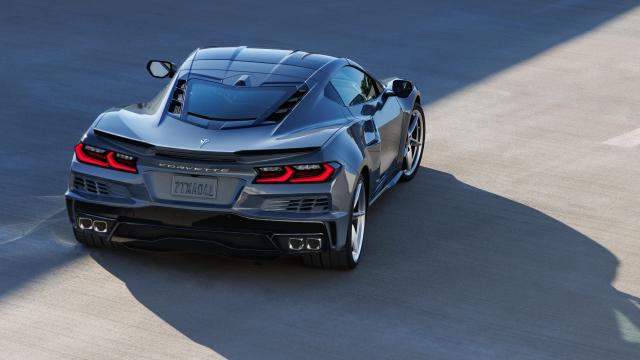The 2024 Chevy Corvette E-Ray achieves a lot of Corvette firsts. It’s the first hybrid Corvette, and the first with all-wheel drive. It’s got a lithium-ion battery tucked between the seats. It even offers Stealth Mode for silent all-electric propulsion, so you don’t wake the neighbours with that 6.2-litre small-block V8. But there’s one thing the E-Ray doesn’t have: A charging port. So why didn’t Chevy make the first hybrid Corvette a plug-in?
It all comes down to the size of that battery, and what it’s expected to do. The E-Ray’s lithium-ion battery pack is, in a word, tiny — just 1.9 kWh. A 2022 Chevy Bolt’s battery measures in at 65 kWh, more than 34 times the total energy storage capacity of the E-Ray’s pack. But where the Bolt has to give you enough juice to drive more than 322 km, while powering things like the headlights and HVAC, the E-Ray’s battery only has to deliver power to the front axle motor in short bursts, replenishing its charge via regeneration. So Corvette engineers could spec a compact, lightweight battery, that could more easily fit in the sports car’s chassis.
“It’s all about power in, power out, not how much energy we can store in that little space,” global Corvette executive chief engineer Tadge Juechter told me at an E-Ray sneak peek at GM’s Milford Proving Grounds. “It’s a small battery, not a lot of EV range anyway. It’s all about how you get a relatively lightweight solution that gets the power.” Juechter told me the battery in the E-Ray weighs just over 45 kg — minuscule by EV standards.
“The battery is designed to dump as much energy as it possibly can, as quickly as it can, to the drive unit,” Mark Stheiner, assistant chief engineer for hybrid drive systems, told me. “That means it depletes itself quickly, but it also can regenerate from the front drive unit at a super high rate.”

Stheiner offered a contrast with another GM product: The GMC Hummer EV. The Hummer has a huge, 210-kWh battery pack, capable of pushing the 4,082 kg pickup truck well past 483 km of driving range. The Hummer is also capable of a 3-second 0-60 time, but even when you’re ripping drag launches, you’re only using a sliver of the battery’s total power. The rest goes into getting you home.
The E-Ray can only cover about 5 km in pure EV mode before the gasoline engine kicks in. But because the battery is so small, the front-axle electric motor can replenish it through regeneration extremely quickly. Every time you brake, or even just lift off the throttle, the front axle goes into regen, pumping energy back into the battery. In extreme cases, the e-AWD motor might even add a slight amount of regen drag while driving, just to get the battery back up to a comfortable state of charge.
So why no plug-in capability? “Plug-in adds hardware, so we’d have to add mass and packaging,” Stheiner told me. “And, the battery is super small capacity. Offboard charging would be a non-event. You’d get home, plug it in, go take your shoes off, and you’d be ready to unplug it.”
The electric drive system in the E-Ray is programmed to top up the battery wherever it can, compiling tiny moments of regeneration to add up to a healthy charge. Even in extreme driving conditions, Juechter and his team found it hard to get the battery depleted to a point where it would be a problem. “We go out and hammer on the car — 99th percentile aggressiveness for a customer driving on public roads. I’m tapping the battery gauge going, is this thing right? I can’t believe I’m driving like this and it’s still at 80 per cent, 90 per cent state of charge.” For more extreme cases, there’s a “Charge+” button, which is basically meant to bring the battery to 100 per cent before you go out on track for a flying lap.
For everyday driving, you probably won’t even need to touch the Charge+ button. “It’s unlikely you’d pull in your driveway at much less than a full state of charge,” Juechter told me. “Your last braking event coming into the garage is quite likely to top it off.”
